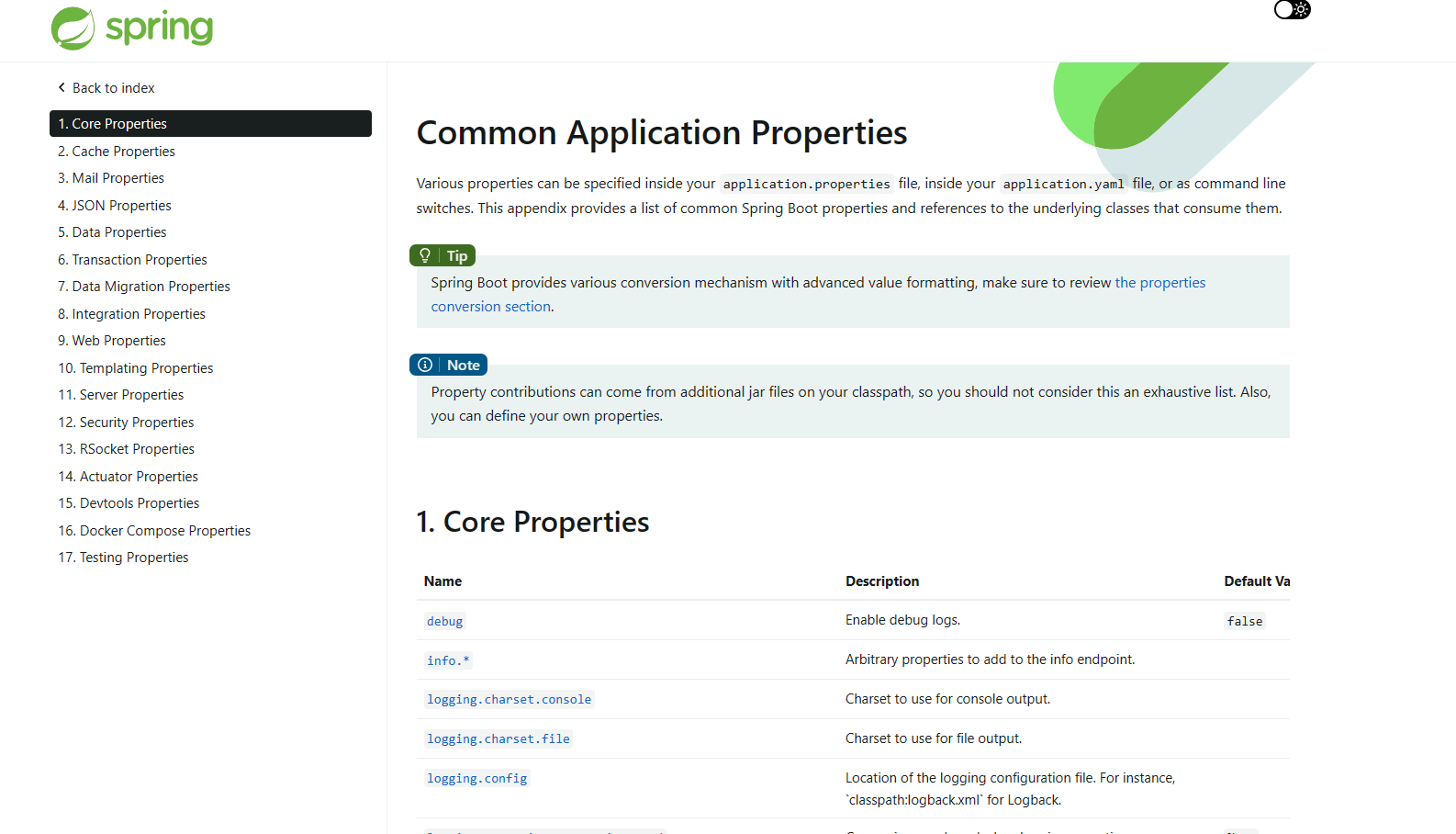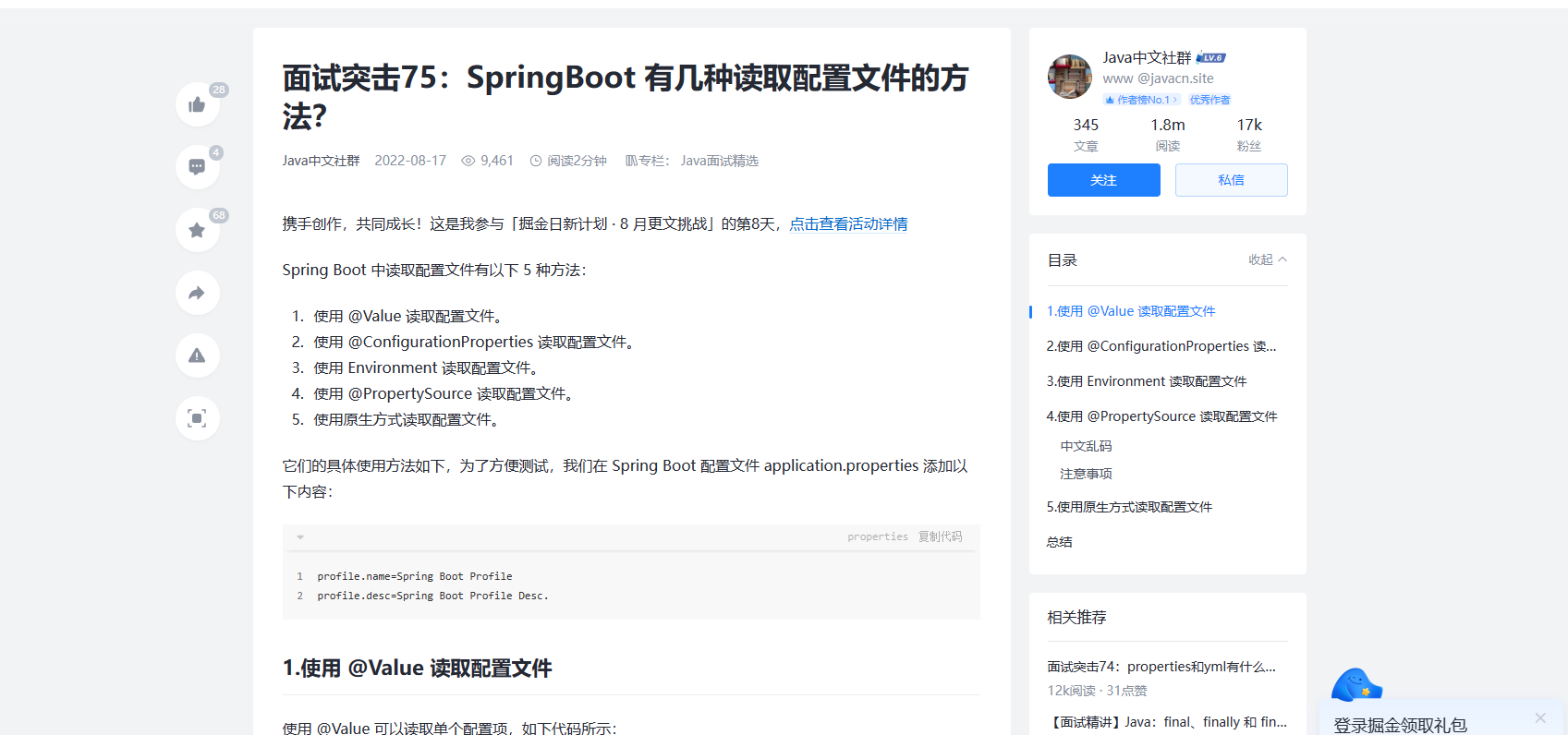一:配置文件概述
(1)配置文件作用
SpringBoot配置文件作用:Spring Boot 的配置文件在应用程序中起着关键的作用,它用于配置应用程序的各种属性、行为和第三方服务的连接信息。通过配置文件,开发者可以在不修改代码的情况下改变应用程序的行为,使得应用程序更加灵活和可配置。主要作用如下
-
配置应用程序属性:配置文件中可以定义各种属性,这些属性可以是数据库连接信息、服务器端口、日志级别等。这些属性的值可以在整个应用程序中使用,通过这种方式实现了应用程序的参数化配置

-
配置文件优先级:Spring Boot 配置文件具有优先级顺序,系统会按照一定的规则来加载配置文件。例如,
application.properties的配置项会被默认加载,而同样的配置项在其他配置文件中也可以被覆盖。这种优先级机制使得配置更加灵活 -
多环境配置:Spring Boot 支持在不同的环境下使用不同的配置文件。例如,可以有一个
application-dev.properties用于开发环境,application-prod.properties用于生产环境。通过设置不同的配置文件,可以方便地切换不同环境下的配置 -
外部配置:Spring Boot 支持在外部指定配置文件的位置,可以通过命令行参数、环境变量或者其他方式指定配置文件的路径,从而实现更好的配置管理
-
配置注解:除了配置文件,Spring Boot 还支持使用注解来进行配置。通过在代码中使用
@Value、@ConfigurationProperties等注解,可以将配置文件中的属性值注入到相应的 Java 类中,实现更灵活的配置
(2)配置文件分类
SpringBoot配置文件分类:
- 系统配置文件: 例如端口号的设置,连接数据的配置
- 用户自定义配置文件:
(3)配置文件格式
SpringBoot配置文件格式:主要分为以下两种格式
- Properties 格式: 是一种键值对的文本文件格式,常用于配置文件。在 Spring Boot 中,通常使用
.properties扩展名的文件

- YAML格式: 是一种人类可读的数据序列化格式,常用于配置文件。在 Spring Boot 中,通常使用 .yml 或 .yaml 扩展名的文件

.properties文件和.yml文件是可以共存于一个项目当中的。如果同时存在两个配置文件,就会优先选用.properties文件(加载完之后仍然会加载.yml文件配置信息)。虽然两者可以共存,但是在实际业务中,我们一般会采取统一的配置文件格式
二:properties配置文件说明
(1)基本语法
基本语法:
- 语法:
key=value - 注释:
#
server.port=8080
spring.datasource.url=jdbc:mysql://localhost:3306/mydatabase
logging.level.root=debug
(2)读取配置文件
在项目中读取配置文件可以使用@Value注解,格式为@Value("${}")
test="zhangsan"
package com.example.springbootfirst2023_11_12;
import org.springframework.beans.factory.annotation.Value;
import org.springframework.stereotype.Controller;
import org.springframework.web.bind.annotation.RequestMapping;
import org.springframework.web.bind.annotation.ResponseBody;
@Controller
@ResponseBody
public class TestController {
@Value("${test}")
private String mytest;
@RequestMapping("/getconfig")
public String getConf(){
return mytest;
}
}

(3)缺点
.properties缺点:
- 缺乏层次结构:
.properties文件是平面的键值对,不支持层次结构。这意味着在处理复杂的配置需求时,你可能需要使用多个键值对来模拟层次结构,导致配置文件变得复杂和难以维护 - 不支持复杂的数据类型:
.properties文件中的值都是字符串,不支持复杂的数据类型。当你需要配置复杂的对象或集合时,可能需要手动进行类型转换,增加了额外的代码复杂性 - 不支持动态刷新: 在运行时更新
.properties文件的更改并不会自动反映到应用程序中,除非你使用了Spring Boot的@RefreshScope等特性。这可能导致在进行配置更改时需要重启应用程序 - 无法进行条件化配置: 使用
.properties文件时,难以根据条件来配置不同的属性。Spring Boot 2.4及更高版本引入了更灵活的配置方式,如使用 YAML 文件,并且支持基于条件的配置
三:yml配置文件说明
yml:是YAML的缩写,全称为"Yet Another Markup language",是一种标记语言,有以下优点
- 语言可读性高、写法简单、易于理解,语法和JSON类似
- 支撑更多的数据类型,可以简单表达数组、散列表、标量等数据心态
- 使用空白符号缩进和大量依赖外观的特色
- 支撑更多的编程语言
(1)基本语法
基本语法:
- 语法:
key: value,注意:后面必须有一个空格 - 注释:
#
server:
port: 8080
spring:
datasource:
url: jdbc:mysql://localhost:3306/mydatabase
profiles:
active: dev
(2)读取配置文件
任然使用@Value("${}")读取
test: "lisi"
package com.example.springbootfirst2023_11_12;
import org.springframework.beans.factory.annotation.Value;
import org.springframework.stereotype.Controller;
import org.springframework.web.bind.annotation.RequestMapping;
import org.springframework.web.bind.annotation.ResponseBody;
@Controller
@ResponseBody
public class TestController {
@Value("${test}")
private String mytest;
@RequestMapping("/getconfig")
public String getConf(){
return mytest;
}
}

(3)使用进阶
A:配置其他数据类型
如下
# 字符串
string.value: Hello
# 布尔值
boolean.value: true
boolean.value1: false
# 整数
int.value: 10
int.value1: 0b # 二进制
# 浮点数
float.value: 3.14159
float.value1: 3.14159e-5
# Null
null.value: ~
B:配置对象
在yml中可以使用如下两种方式配置对象
# 方式一
student:
id: 1
name: "zhangsan"
age: 18
# 方式二
student: {id: 1,name: "zhangsan", age:18}
这时候就需要另外一个注解@ConfigurationProperties进行读取
1:创建一个实体类,并加入注解
package com.example.springbootfirst2023_11_12;
import lombok.Getter;
import lombok.Setter;
import lombok.ToString;
import org.springframework.boot.context.properties.ConfigurationProperties;
import org.springframework.stereotype.Component;
@Component
@ConfigurationProperties("student")
@Getter
@Setter
@ToString
public class Student {
private int id;
private String name;
private int age;
}
2:进行调用
package com.example.springbootfirst2023_11_12;
import org.springframework.beans.factory.annotation.Autowired;
import org.springframework.beans.factory.annotation.Value;
import org.springframework.boot.context.properties.ConfigurationProperties;
import org.springframework.stereotype.Controller;
import org.springframework.web.bind.annotation.RequestMapping;
import org.springframework.web.bind.annotation.ResponseBody;
@Controller
@ResponseBody
public class TestController {
@Autowired
private Student student;
@RequestMapping("/getconfig")
public void getConf(){
System.out.println(student);
}
}
3:效果

C:配置集合
方法如下
# 方式一
dtypes:
name:
- mysql
- sqlserver
- db2
# 方式二
dbtypes: {name: [mysql,sqlserver,db2]}
读取方式如下
1:创建一个实体类,并加入注解
package com.example.springbootfirst2023_11_12;
import lombok.Data;
import org.springframework.boot.context.properties.ConfigurationProperties;
import org.springframework.stereotype.Component;
import java.util.List;
@Component
@ConfigurationProperties("dbtypes")
@Data
public class ListTest {
private List<String> name;
}
2:进行调用
package com.example.springbootfirst2023_11_12;
import org.springframework.beans.factory.annotation.Autowired;
import org.springframework.beans.factory.annotation.Value;
import org.springframework.boot.context.properties.ConfigurationProperties;
import org.springframework.stereotype.Controller;
import org.springframework.web.bind.annotation.RequestMapping;
import org.springframework.web.bind.annotation.ResponseBody;
@Controller
@ResponseBody
public class TestController {
@Autowired
private ListTest listTest;
@RequestMapping("/getconfig")
public void getConf(){
System.out.println(listTest);
}
}
3:效果

四:其他
(1)设置不同环境的配置文件
一般来说,开发环境、生产环境的配置信息是不同的,所以我们要创建属于不同环境下配置文件,如下

使用时在主配置文件(appliaction.yml)指定具体环境即可

(2)其他配置项
更多配置项请见官方文档:点击跳转

(3)SpringBoot读取配置文件的几种方式
具体请见该博客:点击跳转



评论区